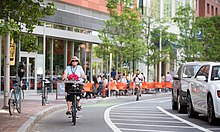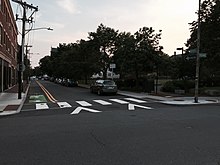Bike lane

This article needs additional citations for verification. (June 2021) |
Bike lanes (US) or cycle lanes (UK) are types of bikeways (cycleways) with lanes on the roadway for cyclists only. In the United Kingdom, an on-road cycle-lane can be firmly restricted to cycles (marked with a solid white line, entry by motor vehicles is prohibited) or advisory (marked with a broken white line, entry by motor vehicles is permitted). In the United States, a designated bicycle lane (1988 MUTCD) or class II bikeway (Caltrans) is always marked by a solid white stripe on the pavement and is for 'preferential use' by bicyclists. There is also a class III bicycle route, which has roadside signs suggesting a route for cyclists, and urging sharing the road. A class IV separated bike way (Caltrans) is a bike lane that is physically separate from motor traffic and restricted to bicyclists only.

United States[]
According to the National Association of City Transportation Officials (NACTO) bike lanes are an exclusive space for cyclists by using pavement markings and signage.[1] Bike lanes flow in the same direction as motor vehicle traffic and is located adjacent to vehicle movement. Conventional bike lanes provide limited buffer space between vehicles cyclists, as those with protective space are referred to as buffered-bike lanes. Buffered bike lanes are similar to conventional lanes but provide a buffered space between vehicles and cyclists hence the name. The extra space can be between moving vehicles and/or parked vehicles and is typically 3-feet wide, the width of a car door. Contra-Flow Bike Lanes allow cyclists to travel in the opposite direction of vehicle traffic flow. Contra-Flow lanes are found on one-way streets that then allow two-way directional traffic for cyclists. Left-Side Bike Lanes are lanes placed on the left side of one-way streets, or along a median on two-way divided streets.

The Manual on Uniform Traffic Control Devices (MUTCD) by the U.S. Department of Transportation Federal Highway Administration (FHA) gives standards of how bike lanes should be implemented regarding pavement markings and signage. These can include the word, symbol, and arrow size to be used in a bike lane and the width of the lane itself, which ranges from 5-7 feet.[3] Cities across America are actively expanding their amount of bike lanes, such as in Boston, Massachusetts where they have created city-wide goals, Go Boston 2030, to increase their bike network.
Europe[]

In France, segregated cycling facilities on the carriageway are called bande cyclable, those beside the carriageway or totally independent ones piste cyclable, all together voie cyclable.[4] In Belgium, traffic laws do not distinguish cycle lanes from cyclepaths. Cycle lanes are marked by two parallel broken white lines, and they are defined as being "not wide enough to allow use by motor vehicles". There is some confusion possible here: both in French (piste cyclable) and in Dutch (fietspad) the term for these lanes can also denote a segregated cycle track, marked by a road sign; the cycle lane is therefore often referred to as a "piste cyclable marquée" (in French) or a "gemarkeerd fietspad" (in Dutch), i.e. a cycle lane/track which is "marked" (i.e. identified by road markings) rather than one which is identified by a road sign. In the Netherlands the cycle lane is normally called "fietsstrook" instead of "fietspad".
According to a 2019 study, cities with separated bike lanes had 44% fewer road fatalities and 50% fewer serious injuries from crashes. The relationship was particularly strong in cities were bike lanes were separated from car lanes with physical barriers.[5][6] Research published in 2020 showed insights from communities where on-road cycling for transportation is less common, particularly in the Southeast U.S. and reported that potential bikers say separated bike lanes would make them more likely to participate in active transportation.[7]
A 2021 review of existing research found that closing car lanes and replacing them with bike lanes or pedestrian lanes had positive or non-significant economic effects on nearby businesses.[8]
See also[]
- Bikeway safety, including studies on the safety of cycle tracks
- Bikeway and legislation
- Cycling infrastructure
- Pop-up bicycle lane
References[]
- ^ "Urban Bikeway Design Guide". National Association of City Transportation Officials. 2012-06-27. Retrieved 2021-11-04.
- ^ "Chapter 9C - MUTCD 2009 Edition - FHWA". mutcd.fhwa.dot.gov. Retrieved 2021-12-05.
- ^ "Chapter 9C - MUTCD 2009 Edition - FHWA". mutcd.fhwa.dot.gov. Retrieved 2021-12-05.
- ^ French bicycle association FUBi, Pistes et bandes cyclables
- ^ Marshall, Wesley E.; Ferenchak, Nicholas N. (2019-05-29). "Why cities with high bicycling rates are safer for all road users". Journal of Transport & Health. 13: 100539. doi:10.1016/j.jth.2019.03.004. ISSN 2214-1405.
- ^ "Separated Bike Lanes Means Safer Streets, Study Says". Streetsblog USA. 2019-05-29. Retrieved 2019-06-01.
- ^ Watkins, Kari Edison; Clark, Calvin; Mokhtarian, Patricia; Circella, Giovanni; Handy, Susan; Kendall, Alison (2020-05-07). Bicyclist Facility Preferences and Effects on Increasing Bicycle Trips. Transportation Research Board, National Academies of Sciences, Engineering, and Medicine. doi:10.17226/25792. ISBN 978-0-309-48127-4.
- ^ Volker, Jamey M. B.; Handy, Susan (2021-04-12). "Economic impacts on local businesses of investments in bicycle and pedestrian infrastructure: a review of the evidence". Transport Reviews: 1–31. doi:10.1080/01441647.2021.1912849. ISSN 0144-1647.
External links[]
- Urban Bikeway Design Guide from National Association of City Transportation Officials
 Media related to Cycle lanes at Wikimedia Commons
Media related to Cycle lanes at Wikimedia Commons
- Cycling infrastructure
- Cycling
- Transport infrastructure